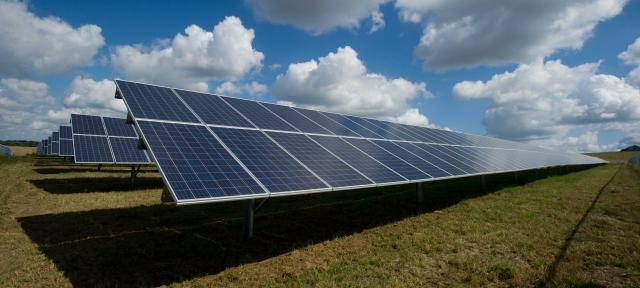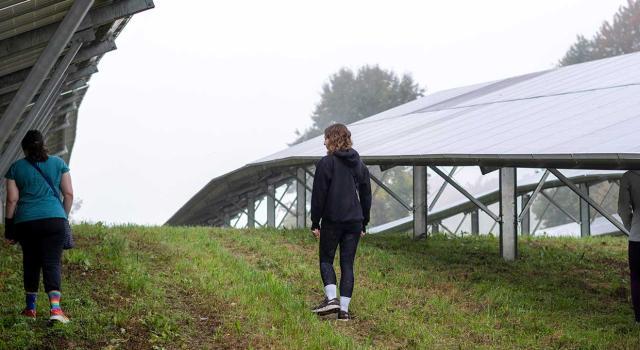Recent Graduate Flynn Hibbs 17F on the Impact of Solar Development on Wildlife

Flynn Hibbs’s 17F Div III combined experience in ecological research with an interest in sustainable development to produce valuable research on the effect of large-scale solar arrays on animals.
Flynn connected with Hampshire College Sustainability Manager Sara Draper to share her Div III, “Ecological Effects of Utility-Scale Solar Arrays on Macrofauna in New England,” and chat about the influence it could have with communities like Amherst.
Tell me a bit about your Hampshire experience.
I came to Hampshire interested in ecology and conservation, but not sure what direction that would take me. I took courses in animal behavior, conservation biology, and global change ecology, and worked as a teaching assistant for a course on biodiversity in the Hampshire woods. I took a field course surveying marine mammals in Chile during one January term and spent a summer at an undergrad research experience at the University of Texas in El Paso. I also worked at the Hitchcock Center for the Environment [on the Hampshire campus], as an assistant and an animal caretaker, and was on the Hampshire Farm Committee.
Wow, you were busy! How did you come to focus on wildlife and solar for your Div III?
When I first came to college, I thought of solar development as an obviously good thing. Working with Assistant Professor of Ecosystem Ecology Seeta Sistla, I started to think about the larger potential impacts of land use, nutrient cycling, microorganisms in the soil, changing invertebrate population, and faunal habitat.
Large-scale solar developments are a huge land use change! The small things that happen in and near the array can have big consequences for local wildlife and other ecological conditions. This is still a new area of research, so there is a lot we don’t know yet.
For my Div III, the primary focus was on wildlife. I wanted to know: Is there a difference in species diversity and abundance inside and outside the solar arrays? I was also interested in exploring possible supportive relationships between wildlife and solar developments by asking, Is it worth it to foster wildlife spaces within solar arrays? Or is it unsafe or otherwise detrimental?
How did you go about answering those questions?
I looked at four different large-scale solar arrays in the Connecticut River Valley, two of which are on Hampshire’s campus. I worked with the site managers to get access and research permission, and developed research methodology with my committee members, Associate Professor of Animal Behavior Sarah Partan and Assistant Professor of Plant Science Blair McLaughlin. I posted wildlife cameras in various locations inside and outside the arrays designed to capture images of visiting mammals and birds. I then analyzed the footage to compare species diversity and abundance within the array boundaries to the adjacent areas.
Solar is going to be such a big component of land use in the future, and it could be a real area of opportunity to develop mutually beneficial strategies that support wildlife and renewable energy needs.Flynn Hibbs 17F
What did you find?
Well, I can tell you that the solar fields I studied were not industrial wastelands devoid of wildlife. In my field visits, I noticed a lot of wildlife signs within the arrays—nesting, burrowing—and animals seemed to be using the space for their needs. My trail cams picked up bears, bobcats, rabbits, foxes, deer, and dozens of species of birds. The trail cam can really only capture larger mammals, and it isn’t possible to identify individuals or to fully capture bird populations or small rodents. I did identify one endangered bird within an array and some species of concern, but I mostly found generalists.
I was also able to see the effect of some of the different design strategies used at different sites. The site at Mt. Tom had a wildlife clearance built into the fence (a raised fence bottom to allow animals to enter and leave freely), and there were more large mammals like coyotes and bobcats entering that site. These species are known as ecosystem engineers, so their presence shows a continuation of normal ecosystem roles within the space.
What do you hope to see in future solar development?
Solar is going to be such a big component of land use in the future, and it could be a real area of opportunity to develop mutually beneficial strategies that support wildlife and renewable energy needs. The most important thing is thoughtful siting. There is a chance for solar to improve the places we put it—to allow for the resurgence of native flora or to restore degraded or contaminated land. There have been projects on making spaces pollinator-friendly, and there’s policy right now in Massachusetts to support that. There are even places combining sheep grazing and solar to provide multiple benefits to farmers.
I’ve heard about a solar project in a California array that is specifically designed to help an endangered fox species. The fence is designed to allow the foxes to enter, but to exclude coyotes (their primary competitor) to help conserve this endangered species. I wonder what species we can help thrive in New England through thoughtful solar design?
What thoughts can you offer for towns like Amherst that are grappling with questions on solar development?
I think we need to expand our idea of what a solar array is! We can have conservation measures, and we can think about how we design and how it melds with ecological principles while also producing the energy we need. Unfortunately, right now, the bottom line in large-scale solar developments is maximum energy production and low cost. We could leverage policy to push developers to create arrays that are ecologically beneficial. I think it’s cool to see communities take on this challenge, to define what we do want to see in solar development.
One challenge is making the solar companies care about the site and its impact on the health and biodiversity of the local ecosystem. Many of these solar developers are fossil fuel companies moving into renewables, so there isn’t really a culture of caring about impact; I felt this in some of my conversations with site maintainers and installers—it was just a job. But I also got a lot of support from the energy company at the Mt. Tom site. They invited me to present my research, and almost 100 employees attended the remote presentation and were very interested in the work. More interactions like this are needed if we’re going to get everyone involved to care about the full range of impacts from solar development.
What have you been up to since graduation?
Right after graduation, I interned in the agroecology lab at the Archbold Biological Station in Florida, exploring how to apply conservation ethics to make the cattle industry more sustainable. I helped launch a precipitation manipulation experiment and conducted research on the relationship of sunlight and soil in plant-plant interactions in sub-tropical, semi-native grasslands at Buck Island Ranch.
I have complicated feelings about pursuing more research positions. My experience during the early Covid-19 pandemic made me want to move toward working primarily outside and spending more time in nature. I've just started a new adventure as a crew member with the wildland restoration team with the Montana Conservation Corps. I’ll be doing fieldwork, backpacking in Montana and Idaho doing invasive species removal, re-vegetation, and stream restoration. My experiences in Hampshire's Outdoor Programs, Recreation, and Athletics backpacking and orienteering courses helped prepare me for this type of work and definitely added to my resume. I’m still exploring what the most tangible and meaningful work is for me, and am excited for this new adventure!
Any final thoughts for future Hampshire students or budding ecologists?
Read Braiding Sweetgrass by Robin Wall Kimmerer! That book helped me to think about ecology as a form of community care; the health of our families and communities is tied to the health of our ecosystem. And get out in the Hampshire woods and get to know the local plants and animals. Treat them as if they’re your neighbors, learn their names; they may be a vital part of your Hampshire experience and future work!



